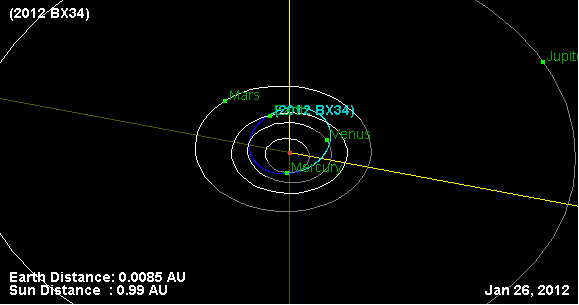[/caption]
A small asteroid will pass extremely close to Earth tomorrow (January 27, 2012). Named 2012 BX34, this 11 meter- (36 feet-) wide 8 meter- (26-foot-) space rock (astronomers have updated their estimates of the size) will skim Earth less than 60,000 km (37,000 miles, .0004 AU)>, at around 15:30 UTC, (10:30 am EST) according to the Minor Planet Center. The latest estimates have this small bus-sized asteroid it traveling at about about 8,900 meters/second (about 20,000 miles per hour). 2012 BX34 has been observed by the Catalina Sky Survey and the Mt. Lemmon Survey in Arizona, and the Magdalena Ridge Observatory in New Mexico, so its orbit is well defined and there is no risk of impact to Earth.
Via the @AsteroidWatch Twitter feed, scientists from JPL said “It wouldn’t get through our atmosphere intact even if it dared to try.”
Amateur astronomers in the right place and time could view this object, as it should be about magnitude 14 at the time of closest approach. Click here to see a current orbit diagram, and here to view the ephemeris data. Nick Howes, with the Faulkes Telescope Project said his team is hoping to observe and image the asteroid, — although they aren’t sure if they will be able — but we hope to share their images later.
Update: see images from astronomers on our latest article regarding 2012 BX34
Hat Tip: Nick Howes


1,600 ft per minute? Seems a bit of a slowpoke.
I think you have made a mistake in your unit conversion. The asteroid is travelling at 8,900 m/s, which is more than 300 times faster than your figure.
I wrote the speed exactly as it was written in the original story here. I didn’t covert anything. Someone has correct what was originally posted.
We are doomed dooooooommmed!!!!
YU55 was actually very hard to take an image of last time. My coordinates always missed the object.
Can someone post a link to see the trajectory so we can see if it will be passing over at night. Should be clear in the southeast USA tomorrow night. Would be cool to show my kids.
tak
when NASA updated the size info did they also up date the AU? The ACTUAL is 5.0E-4AU … sounds good right!
I find it a bit odd that they listed the AU conversion in the first place. The object will come within the orbit of the moon, so why would the Sun-Earth distance be relevant or helpful?
I imagine to get a better picture of its actual distance from earth? that number was pulled from jpl small body. NASA put it there so why they calculate the way they do is totally within their reasoning. Am i missing the point here?
I think is see what your saying now. The Moons distance is also commonly used in AUs 0.00257 A.U. (3.84400 x 10^5 km)